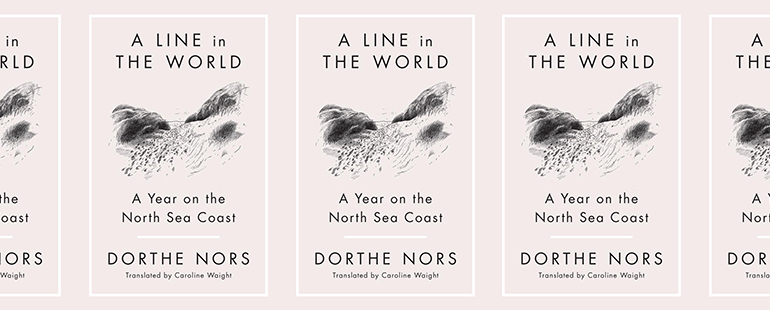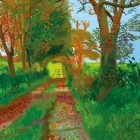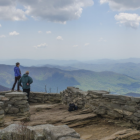A Line in the World’s Imaginings

As clear as any demarcation on a map, Dorthe Nors’s A Line in the World: A Year on the North Sea, published last fall, is a book with an intention. As she writes in the book’s grounding opening essay, her aim is to unearth the stories of Denmark’s wild and stark western coast, which is also the eastern coast of the North Sea: “A landscape is beyond the telling, like the telling is beyond itself. It takes a person to take up the line somewhere, to open, look and make a cut. This coming year it’ll be me, gently guiding the scalpel as I write.” To envision the prose of this book as a scalpel—spare, glinting, cold but also warmed by the wielder’s hand—is apt. Over and over again, Nors writes of a landscape alienated—by the detritus of war, pollution, and the pull of more urban centers—and alienating—by insular communities and an unforgiving landscape—but she does so with curiosity and frank fondness rooted in memory and experience. The essays here track the ways Nors uses her year to immerse herself in the place, including deliberate research trips and more incidental encounters, and the somewhat unstructured way the content of each essay arrives, per the project of the book: “As much as possible, I’d rather be open to the truth that arises between me and the place, at the moment we meet.” True also—and surprising and pleasurable—is the discovery of how fully that truth emerges from the most overtly imagined passages in the book. These imaginings create an embodied landscape lush with life, reverberating with echoes of voices, human and otherwise.
The essayist’s particular trick of “perhapsing,” as Lisa Knopp names it, allows speculation and even wholesale invention into works of creative nonfiction. With a strategically placed “I imagine” or a “maybe,” an avenue arrives for inclusion of certain unknowable elements: another person’s innermost thoughts, the way something happened in the writer’s absence, a scene recreated from someone else’s telling. Part of Nors’s work is to voice the unvoiceable: the people relegated to the margins of history and even the very geography she sets out to explore. As Nors writes, “But now I have claimed the right to see and to describe. The landscape must have an essence that, in itself, can speak.” Her task, then, is to listen for that voice and bring it to the page.
But first, the people. Early on, Nors makes use of a “we” that hinges on shared cultural markers, as shown in the second essay, “The Shortest Night.” She writes, “The light is here, but the darkness is as well, and now the great wheel turns. We walk to the holy springs and wash our wounds…Our brown calves are wet with cuckoo spit.” These are the actions of the collective, both historical and present-day, demonstrating cultural ritual and the repetition of the seasons’ turning, but Nors breaks the illusory collective: “We burn a female doll in that opening, and I’ve never felt much like taking part.” The prose, with its clearly described actions, takes part, but the narrator is free to remain separate, sculpting the moment from memory and observation, yes, but also by imagining the practice as it appears to the ones who do wish to take part. It’s a step simultaneously authoritative and self-effacing. Later, she does something similarly declarative and evasive as she imagines a man credited with building one of the lighthouses she visits: “I picture Skafte being heavy round the middle. A walrus moustache and bristling, irascible hair. He sees himself standing by the door, bidding his visitors welcome as he fiddles with his gold watch. I can’t know that last bit, of course, but that it was Skafte who built it I do know, because I asked.” By making these perhapsings so overt in the early part of the book, she prepares the reader for more exciting leaps.
In “The Tracks around Bulbjerg,” Nors uses her “collective culturally determined memory” to imagine this place before World War II, a war literally embedded in the landscape along the North Sea coast. In the process, vacationers and strollers animate the hotel that once stood in this place; Nors’s imaginings set another writer, Thit Jensen, more than fifty years dead, back into motion through the world, complete with her own inner life restored upon the page. The people very much become part of the place, and the reader becomes a collaborator in the process of creating it, imagining along with the narrator this scene that perhaps never was but is no less vital for that. Similarly, and even more intensely for how the moment braids together the distant past and the present, is Nors’ contemplation of a medieval painter. She and an artist friend make a day of searching out frescoes in the small, quiet churches along this coast:
We are quiet, side by side in the church on the edge of the sea, while the master speaks. He tells us of senses and longing. He turns his soft face towards us. He is a human being, coming timelessly towards us. What he says, he says clearly. Nothing has been lost, despite the peeling and the interfering conservators. He is here, just as he was here; and we are here, as we have always been. The storm is here. The silence at the altar, and perhaps there’s a small mirror behind it. It’s screwed firmly onto the back, so that the priest, who is now a woman, can pin her braid properly onto her head. Brush a hand across her brow, examine her face on Sunday morning. Now she draws her garment around her. Her hip outthrust, she steps in front of the congregation. Speaks.
In this moment, hundreds of years become a single moment: the painter of the far past and the woman priest mere days ago, and the narrator witnessing and imagining both into being. It’s an impossibility and a joy, and the still, empty church is suddenly filled with presence. Nors creates the same effect beyond the human world. Shipping containers “are exhaling,” are “steeling themselves” for their next journey through difficult waters. On one hand, the containers work as metonymy for the ship’s sailors doing the same things, playing cards as they wait, and yet there is a certain literalness to the rendering, courtesy of Nors’s tightly lyrical prose. Storms, which have an understandably outsized effect on this coastal environment, “have eyes. Their eyes are round and they whirr.” A seal glimpsed in the water becomes strange, almost sinister, “a sodden demon,” then turns over and becomes soft and dog-like. This dual being speaks in the same intimate and dangerous voice she imagines for the sea a few pages before: “‘Here you have me. Here you have my salt teeth.’”
In addition to continuing to animate the landscape and its history—an endeavor that primarily looks outward—A Line in the World is also very clearly an intensely personal endeavor. The imagined voice of the sea recalls an incident from the book’s opening gambit, where Nors narrates the danger of hidden currents, calling them “Valkyrie waves” that will “take you to sea if they can.” She says, “I’m afraid of them, and every time I see them, I remember love.” The love is likely the love of and for her mother, who rescues her from the wave, but the fearful attraction to this salt-toothed sea, the magnetism of it, cannot be denied. Though Nors is sparing in the inclusion of personal details, only lightly sketching the heartbreak of a relationship with a married man and grief over an uncle killed in a car crash in various points across the book, the larger project of the book is rich with the revealing of emotional truth: “A horizon is what I want, and I want solitude. Healthy solitude, and I want intimacy, true intimacy. I no longer want to be anyone but myself.” There is no way to conceive of these many imaginings—voiced and unvoiced—as anything but intimate. Because they are imagined, they are also a kind of solitude, and those imaginings even extend to the self, declaring what might be, what is, and what is impossible, all at once: “You will become a real and beautiful person. You will, but you couldn’t, and so you became something else: a movement pinned in one place.” So imagined, these passages map the line of a self, too, and the workings of an essayist’s mind, making a track the reader can follow through this place alive with possibility.



